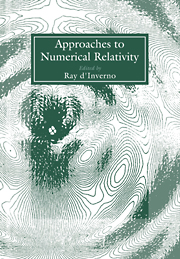Book contents
- Frontmatter
- Contents
- Contributors
- Introduction
- Preface
- PART A THEORETICAL APPROACHES
- PART B PRACTICAL APPROACHES
- Numerical asymptotics
- Instabilities in rapidly rotating polytropes
- Gravitational radiation from coalescing binary neutron stars
- “Critical” behaviour in massless scalar field collapse
- Godunov-type methods applied to general relativistic stellar collapse
- Astrophysical sources of gravitational waves and neutrinos
- Gravitational radiation from 3D gravitational stellar core collapse
- A vacuum fully relativistic 3D numerical code
- Solution of elliptic equations in numerical relativity using multiquadrics
- Self-gravitating thin discs around rotating black holes
- An ADI scheme for a black hole problem
- Time-symmetric ADI and causal reconnection
- The numerical study of topological defects
- Computations of bubble growth during the cosmological quark-hadron transition
- Initial data of axisymmetric gravitational waves with a cosmological constant
- PANEL DISCUSSION
Self-gravitating thin discs around rotating black holes
Published online by Cambridge University Press: 15 December 2009
- Frontmatter
- Contents
- Contributors
- Introduction
- Preface
- PART A THEORETICAL APPROACHES
- PART B PRACTICAL APPROACHES
- Numerical asymptotics
- Instabilities in rapidly rotating polytropes
- Gravitational radiation from coalescing binary neutron stars
- “Critical” behaviour in massless scalar field collapse
- Godunov-type methods applied to general relativistic stellar collapse
- Astrophysical sources of gravitational waves and neutrinos
- Gravitational radiation from 3D gravitational stellar core collapse
- A vacuum fully relativistic 3D numerical code
- Solution of elliptic equations in numerical relativity using multiquadrics
- Self-gravitating thin discs around rotating black holes
- An ADI scheme for a black hole problem
- Time-symmetric ADI and causal reconnection
- The numerical study of topological defects
- Computations of bubble growth during the cosmological quark-hadron transition
- Initial data of axisymmetric gravitational waves with a cosmological constant
- PANEL DISCUSSION
Summary
Abstract. We have constructed sequences of equilibrium numerical models for selfgravitating thin discs around rotating black holes. The multigrid method has been used for solving numerically the stationary and axisymmetric Einstein equations describing the problem.
INTRODUCTION
We solved numerically Einstein's equations for equilibrium configurations made by self–gravitating thin discs around rapidly rotating black holes. These configurations may play an important role in modelling active galactic nuclei (AGN) since the self–gravity may induce the so–called “runaway” instability which may be connected with X–ray variability observed in AGNs (Abramowicz et al., 1980, see however Wilson, 1984). Also, such configurations are seen formed in numerical simulations of general relativistic collapse to a black hole (Nakamura, 1981, Stark and Piran, 1986, Nakamura et al., 1987) for some intial conditions.
We consider here only the case in which the disc is thin; for pressure dominated discs (thick discs) work is in progress (see Nishida, Eriguchi and Lanza, 1992). Self–gravitating discs and rings have been considered in the past by Bardeen and Wagoner (1971) (BW) without central body; Will (1974, 1975) has studied weakly self–gravitating rings around slowly rotating black holes.
In order to solve such a highly non–linear problem we employed the multigrid method (MG) as a strategy to solve the finite difference equations which derive from the discretization of Einstein's equations.
- Type
- Chapter
- Information
- Approaches to Numerical Relativity , pp. 281 - 291Publisher: Cambridge University PressPrint publication year: 1992

